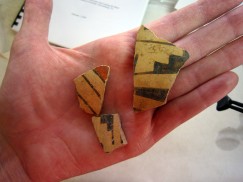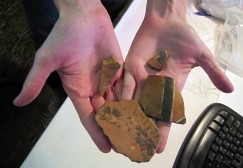- Home
- >
- Preservation Archaeology Blog
- >
- Have Pottery, Will Travel: Trade Ware at Gamalstad
 |
By Katherine A. Dungan, Research Assistant
|
If you’ve been following the blog, you already know a little bit about the Gamalstad site, where we worked in 2009 (you can find my earlier posts here and here). Before we set Gamalstad aside to focus on the upcoming field season, I’d like to discuss some of the non-local ceramics we see at the site, and one highly unexpected type, in particular.
As I wrote earlier, people were living in a pithouse settlement at the site as early as the A.D. 700s, and Gamalstad was occupied, at least intermittently, through the Mimbres Classic period, ending in the 1100s. Most of the ceramic sherds from the site are Mimbres Black-on-white types that would have been made locally or in the larger Mimbres region. The very small amounts of non-local sherds from this time period suggest low-key connections with groups at the southern edge of the Colorado Plateau to the north and with Hohokam groups in southern Arizona. This is fairly similar to the pattern at Wind Mountain, another Late Pithouse and Classic Mimbres site in the Upper Gila.
Gamalstad was reoccupied in the 1300 to 1400s, when we see the same Salado polychrome and Maverick Mountain series types that appear at the 3-Up site. Most of these are probably locally made. Like other Salado sites in the Upper Gila, Gamalstad has a small amount of El Paso Polychrome and Playas Red Incised sherds, probably produced by people living in areas to the south and east. Slightly stranger are the pieces of a Ramos Polychrome vessel, which would have been manufactured in the Casas Grandes region of northern Chihuahua. Although Chihuahuan polychromes have been found at Salado sites in the Upper Gila, these are the only examples we’ve found in Mule Creek.
By far the strangest sherds we found at Gamalstad seem to have come from a single Point of Pines Polychrome bowl, which would have been broken during the Salado occupation. Since our very own Rob Jones wrote his Master’s thesis on the Point of Pines phase, I thought I’d ask him to explain.
Katherine: So, Rob, what exactly is Point of Pines Polychrome?
Rob: Point of Pines Polychrome is a pretty unique ceramic type with an interesting history. It is a poorly made imitation of Fourmile Polychrome, which is made up north in the Silver Creek area of Arizona. We can tell “real” Fourmile Poly by looking at the cross-section and decoration; Point of Pines Poly is made with materials local to the Point of Pines area, now part of the San Carlos Apache reservation.
Katherine: Does this mean it’s unusual to find this type outside of the Point of Pines area?
Rob: Very. The type was probably an attempt by the folks at Point of Pines to make Fourmile when they could no longer get it from the Silver Creek area. It is not very well made or durable, which would have made it a pretty bad trade ware, and it really doesn’t seem to travel much. In my M.A., I argued that the type shows up relatively late in the 1300s, which would make it contemporary with the late occupations at Gamalstad and 3-Up.
The interesting thing about finding it in Mule Creek is that it is just one line of evidence for interaction between Point of Pines and Mule Creek. That interaction is backed up in the Point of Pines area by the presence of Mule Creek obsidian at Point of Pines Pueblo. Put together, this implies some social interaction between those two communities, though we can’t say what kind.
Katherine: There may be some interesting Point of Pines connections involving the great kiva architecture at Fornholt, as well. Thanks, Rob!
This will likely be Gamalstad’s last appearance on the blog, at least for a while. But connections with the Point of Pines area will likely come up again as we work on putting Mule Creek in a regional context.
Explore the News
-
Join Today
Keep up with the latest discoveries in southwestern archaeology. Join today, and receive Archaeology Southwest Magazine, among other member benefits.

